Inevitably you will adopt the time honored principles of “speed is safety” and “light is right.” Weight is great, when you’re in camp decadence. For fast strike tours, or going long and deep, weight is a hazard. Now you’ll be looking for the best balance between performance and a compromise you can live with that chops weight by the pound; a pound here and there adds up quickly.
Light is Right
The best way to save weight is with your binding. The simple answer to “what binding to get” is Dynafit, or a dynafiddle knock off, also generically called a “tech” binding. When Dynafit’s patent expired a number of shops in Europe, most noteably Plum and ATK, began creating their own anorexic versions of an already minimalist binding design. Only G3 dared to offer any significant changes, like more elasticity in the toe, and a heel unit that doesn’t require stepping out of the binding to switch modes.Tech bindings work by latching onto inserts molded into the toe, and mounted to the heel. Two cone shaped pins clamp on to the dimpled inserts at the toe, while two bars of spring steel slide into slots in the heel. The boot is held by these four points exclusively. Lateral release is achieved by the heel unit rotating on a spindle with a companion upward release via the spring bars bending to let go from the heel. The toe jaws can be pried open as the boot twists laterally, until they cam open, releasing the boot.
Tech bindings yield a solid connection with excellent power transfer, but they have a small range of motion before a release is triggered. Thus, this system is prone to release with strong vibrations, like when you’re on firm snow going faster than you should but dared to anyway, or on a hard landing.
If you’re more worried about pre-release than a lack of safety release, the ability for the toe to release can be locked out. Though never advised, plenty of ski mountaineers routinely lock out the release in a tech binding. This begs my original question, “are you serious?” If you are, then welcome to the dynafiddle club. If not, go get a passport binding, the lightest of which is barely ounces lighter than the heaviest tech binding, and noticeably less efficient.
Ultralight Club
Serious weight savers will inevitably consider the race caliber tech bindings. These bindings take the minimalist ethic to sick levels, but the core abilities of having enough tension to hold you solidly to your skis, when locked out, yet add less than eight ounces per foot is compelling, if only just to experience the near absence of the weight of a binding. What you sacrifice is release reliability, ski brakes, and an aggro climbing post. The locked out performance is fully reliable, as long as you don’t make any stupid mistakes. Climbing posts or brakes add convenience, but to a gram-counting racer, unnecessary weight.Light Enough
Most likely you’ll be looking for a fully featured tech binding, with climbing posts, ski brakes and while you’re at it, might as well get some ski crampons. If you’re truly serious, you’ll wish you had them some day, especially if you own them but left ’em behind. Dynafit is still your best choice, either the Radical ST/FT or, if you can find ’em, the Vertical ST/FT (ST has RV from 4-10, FT from 5-12). Plum’s Guide or Yak are nice bindings that are worth considering for their all metal, machined quality, but few will take the seriously without a brake (theoretically available, but as of October 2013, not really).Dynafit’s Radical series uses a new 4-hole pattern for mounting the toe that sports power towers to strengthen the toe piece and make pin alignment for clicking in to the binding easier. The Radical heel breaks from the tradition of being able to rotate the heel clock- or counter-clockwise to switch modes and instead, demands you rotate clockwise only. Experienced dynafiddlers don’t like this limitation, but everyone likes how quickly you can shift up or down to the medium or high climbing posts with a flick of your pole. To the uninitiated, the Radical ST is a no-brainer decision. To the experienced, it requires breaking existing habits, or the heel piece.
Heavy Hitters
If you’re concerned about the safety release of a standard tech binding ‘cuz you aren’t willing to stop charging, in- or out-of-bounds, then you’re a candidate for the most overlooked tech binding, G3’s Onyx, or the new Beast from Dynafit, or Fritschi Diamir’s soon to arriveVipec 12. All these bindings change the standard tech binding equation by increasing the distance the jaws of the toe-piece can spread apart without camming open. In addition, Onyx and Vipec allow you to switch to tour mode without exiting the binding. Which one is for you depends on what your budget is, and who you’re trying to impress, yourself or your friends?
Diamir’s Vipec 12
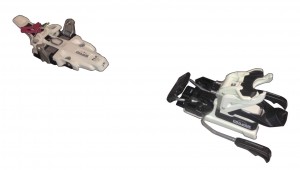
Fritschi joins the Tech binding club with Vipec 12.
Shift on the fly mode switching, elasticity, a mid-range weight,but a heavy price tag.
Dyanfit’s Beast 16
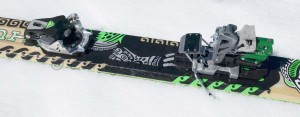
Dynafit breaks the mold with the first tech binding to absorb vibration with RV of 16 and 5° of angular movement of the toe.
The cost of this improved downhill performance is bearable, but barely. Four pounds for the whole shebang seems high, but you won’t be lifting that with each step, just dragging it along, so that’s an easy thing to bear. It requires screwing a special plate to your heel, different from the standard Dynafit heel insert. That’s an easy cost to accommodate if your boot is compatible, not all are. The price is what will kill it for most, a cool C-note if you can’t be bothered with negotiating. If none of those downsides phase you, you’re a candidate.
However, if you’re a core backcountry skier the lack of a flat touring mode will kill your interest in a heartbeat. Crossing the flats in high heels sucks, yet the Beast requires you to do so, or simply avoid the flats – if you can. This is the saddest feature of the Beast because it means that limit will need to be overcome before offering a more reasonably priced variation of this design. It will be interesting to see how Dynafit overcomes this limit.
G3’s Onyx
To be practical, it is hard to ignore G3’s Onyx. It provides greater elasticity by eliminating the ability to cam open. Thus, the jaws can spread, but since they are normally closed, they will always attempt to return to that position. This yields an increase in elasticity at the toe that is limited in normal tech bindings. The cost of this improved ski performance is that the jaws won’t stay open to get your boot in, so you need to actively hold them open with a ski pole. A lot of negativity has been spread about this, but in my experience this toe piece is actually easier to get in to as long as you have created a flat zone to click in from.In addition, the heel retracts to switch to tour mode, no need to exit the binding to free your heel. The price you pay for improved ski performance and convenience is weight, four pounds worth. However, this isn’t like four-pound plate bindings where you’re lifting the whole binding each step, it’s a tech binding where you only lift your boot. Four pounds of drag weight is nothing compared to four pounds of inertia each step of your climb. To help compensate for the weight, you can buy these bindings for four Franklin’s new. Now that’s a bargain!
Tech is not for AT only
Lest you think a tech binding is for alpine touring only, think again. Splitboarders are using tech toe pieces as part of their uphill skinning system. Telemarkers are getting in the game too with the telemark tech system – a tech toe plus a spring-tensioned cable around the heel with NTN boots. The point being, if you’re serious about backcountry skiing, there’s probably a tech binding in your future.
© 2013

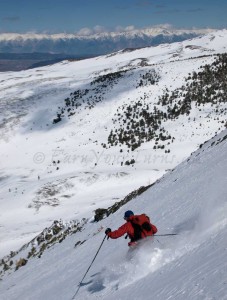
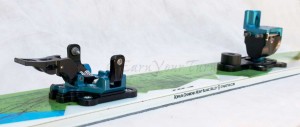
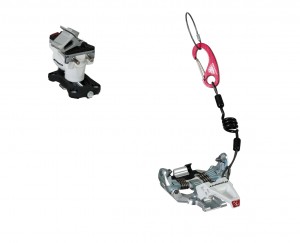
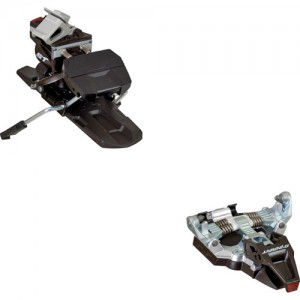
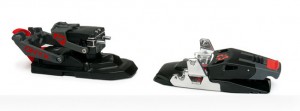
6 pings
[…] Posts First Look: Fritschi’s Vipec 12 Picking the right tech binding 14erskiers Vipec Review […]
[…] insist you can swap those out for alpine DIN sole blocks, but why bother? With all the choices in 2-pin bindings these days, less weight doesn’t necessarily mean less downhill […]
[…] to bear, especially when logging big vertical. When you realize you like earning your turns get a tech binding and save the Trekkers to loan to curious friends who have never been […]